Frequently asked questions
Our FAQs provide quick answers to common questions. If you still need assistance, please contact us on 13 13 65.
Our FAQs provide quick answers to common questions. If you still need assistance, please contact us on 13 13 65.
The NSW Government has updated legislation that aims to reduce the risk of bushfires starting from the electricity supply network. Ausgrid checks its own network as well as private poles and overhead powerlines for any bushfire hazards.
Ausgrid's contractors regularly patrol private poles and overhead powerlines in bushfire-prone areas to help reduce the risk of bushfires and keep the community and your property safe.
Your private poles and powerlines (or ‘poles and wires’) may also be referred to as overhead private and shared mains or as aerial consumers’ mains. Your consumers’ mains include pole-top fittings such as cross-arms and insulators.
Bushfire safety inspections are carried out through ground-based patrols which require inspectors to come onto your property. To prepare for the bushfire danger period, Ausgrid conducts annual visual above-ground inspections of private poles and overhead powerlines in bushfire-prone areas as a priority.
Inspections cover visual checks of private mains, including poles, wires and pole-top fittings for potential bush-fire hazards. We will not inspect sub-mains (the powerlines that extend beyond your main switchboard) unless they are in a continuous overhead line from Ausgrid's service mains and are visually obvious to the inspector.
As part of our Public Safety Awareness Program, Ausgrid annually notifies private poles owners of their obligations for the safe maintenance and operation of electrical installations on their premises.
As a community, we share responsibility for reducing the risk of bushfires. Ausgrid has responsibility for maintaining and repairing its electricity network in the street. Property owners are responsible for the safe maintenance and operation of electrical installations on their premises. All power poles and powerlines between the first point of connection on the property to the switchboard or meter and those that extend into your property are part of your electrical installation and you must ensure they are safe and properly maintained.
Private poles and overhead powerlines should be regularly inspected and properly maintained by authorised contractors. If you notice any of these common defects you will need to organise repairs or tree trimming as soon as possible:
This may include organising a licenced electrician to maintain electricity equipment including power poles, wires and pole-top fittings on their property or engaging a qualified tree trimming contractor to maintain safety clearances between trees and power lines or power poles.
Ausgrid expects you will continue to ensure your private poles and overhead powerlines are safe by arranging an annual bushfire inspection as well as a regular detailed inspection of your power poles.
Refer to the Property Owner's Bushfire Safety Guide for further information.
The Department of Energy providers lists of Accredited Service Providers (ASPs) who can conduct tree trimming and electrical checks or remediation work.
You can also search the Yellow Pages for an 'ASP' in your area.
Ausgrid will issue a defect notice if an inspection has determined there is a bushfire risk. This may be due to :
Common maintenance issues are outlined in our Private Poles and Powerlines guide.
In the interests of public safety, connections to Ausgrid’s electricity network must comply with all relevant safety standards. This includes the Electricity Supply Act 1995, the Electricity (Consumer Safety) Regulation 2006 and Australian Standards and guidelines.
If we find any defects we will leave you a defect notice outlining the work that is required.
It is a property owner's responsibility to arrange and pay for a qualified contractor to carry out the work in the required timeframe.
You must ensure all your poles and overhead powerlines are free from any defects that may cause a bushfire. Broken poles and fittings and powerlines brought down by strong winds, trees and branches can all pose serious safety risks for you and the community.
Any work on electrical equipment, including power poles and lines and fittings, must be carried out by a licensed electrical contractor. Vegetation must only be cleared by a tree trimmer qualified to work around the electricity network.
If vegetation needs to be cleared around your private poles or powerlines you will need to engage a qualified tree trimming contractor to remove it safely.
A list of Accredited Service Providers authorised to work around the electricity network can be found on the Department of Energy website. See also additional Q and As on tree trimming.
Termites, wood rot and rust can all cause serious structural damage to your private power poles. We recommend all termite-infested poles are treated by a registered pest controller. Any unsafe poles must be replaced by a licensed electrical contractor. (Accredited Service Provider). A list of ASPs can be found on the Department of Energy website.
The NSW Electricity Supply Act 1995 requires property owners to respond to defect notices within 30 days.
If you are having difficulty meeting the costs of the required work, Ausgrid has a Customer Assistance Framework and payment plans that may apply in some cases.
The cost of repairing a defect will vary depending on the extent of the damage and other factors such as access to your property and powerlines.
Ausgrid recognises that there are members of the community who experience financial stress and hardship. Our Vulnerable Customer Policy has been developed to assist customers who need to pay Ausgrid directly for bushfire safety rectification work or damage to our network. Find out more.
The following images provides some examples of common defects and a range of indicative costs. These estimates are estimates only and do not allow for issues such as difficult access or specialised equipment, or include potential additional costs for service searches, design, transfer and reinstatement of services to private poles, traffic control or rock excavation.
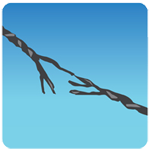
Conductor replacement
Estimated cost: $3600 - $6000
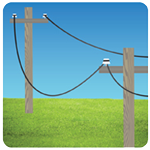
Conductor retensioning
Estimated cost: $1800 - $2800
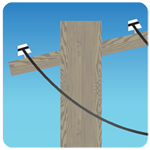
Cross arm replacement
Estimated cost: $1800 - $3000
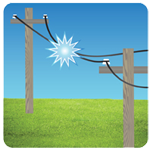
Installation of LV spreaders
Estimated cost: $1200 - $1800
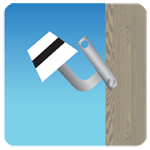
Insulator replacement
Estimated cost: $1500 - $2500
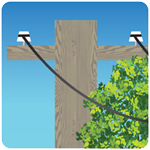
Vegetation management
Estimated costs: 1st span $560 - 2nd span $350 - Additional spans $200
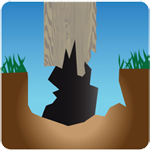
Pole replacement
Estimated costs:
Steel pole $3000 - $5000
Steel pole with meter box $3500 - $5500
Large timber pole $7500 - $14500
Large timber pole with meter box $9500 - $16000
We can complete some above-ground inspections from the property boundary. For private poles and overhead powerlines that can’t be seen easily from the boundary we need to enter your property.
Can I refuse access to my property?
Ausgrid works with the community and authorities such as the Rural Fire Service to reduce the risk of bushfires across our network area. We’re carrying out these patrols to help protect your safety, your property and the community. The Electricity Supply Act 1995 authorises Ausgrid to enter private property to carry out inspections after providing a written notice. In situations where inspectors may need to enter the property we will write to you before the patrol and ask about any special access conditions that we need to observe.
Do I need to be at the property for a bushfire inspection to take place?
You don’t need to be present for the patrol. However, if our inspectors are restricted from accessing your property - for example by locked gates, livestock or dogs - please let us know and we will work with you to complete our patrol.
I have animals on my property and would like to make special arrangements for the inspection.
To discuss your individual circumstances please phone our inspections team using the contact details on the letter we sent to you.
These bushfire safety patrols are carried out by Ausgrid free of charge to help keep the community safe. We will not charge you to inspect your consumers’ mains. However, Ausgrid expects property owners to organise their own regular inspections before each bushfire season, after major storms or if they suspect any damage. This includes any sub-mains on the property that may provide power supply to a pump or shed.
We will not inspect sub-mains beyond the main switchboard or metering unit unless they are in a continuous overhead line from Ausgrid’s service mains and are visually obvious to the inspector.
If we identify any bushfire hazards around your private poles or overhead powerlines we will leave you a defect notice outlining what work is required and the timeframe in which it must be done. The property owner will need to arrange and pay for any work required.
If we do not identify any defects we will leave you a letter and information about maintaining your private poles and powerlines.
Property owners are always responsible for maintaining a safe clearance between your private poles, overhead powerlines and any vegetation on your property. Tree trimming reduces the risk of fires caused by electricity, accidental electrocution and power interruptions caused by branches touching overhead wires.
Depending on the type and size of vegetation on your property that needs to be removed you may need to seek permission from your local council.
As the defect notice will cover work required under the NSW Electricity Supply Act 1995, a qualified contractor is able to trim trees and shrubs to provide a safe clearance around powerlines and power poles, including an allowance for regrowth, without approval from a local council. However, the Ausgrid defect notice does not exempt you from local tree preservation orders. You may need council permission to remove trees. You may also need permission to trim trees if your property is subject to heritage controls or has threatened species and endangered vegetation.
The defect notice does not authorise you to have a qualified tree contractor clear more broadly on your property. Please talk to us about your specific property if you need to clarify what vegetation is covered by the defect notice.
You may need to modify your power supply if the tree poses a bushfire hazard. For example, you may prefer to install your power supply underground. Please contact us if you wish to discuss these options further.
Live powerlines are extremely dangerous and contact with them can be fatal. Electricity can also jump, so you don’t have to be touching powerlines to receive an electric shock. Tree trimmers qualified to work around the electricity network have special training and equipment to help keep themselves and the community safe. Please do not attempt this work yourself.
Both property owners and tenants are responsible for the safe maintenance and operation of electrical installations located on their premises. If you have received a letter or defect notice it is because the letter is sent to or left at the property address.
It is the property owner's responsibility to comply with any direction included in a defect notice. If you are a tenant, you should forward the letter or notice to the property owner or your landlord as soon as possible, and follow up until the matter is resolved.